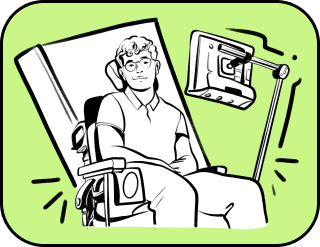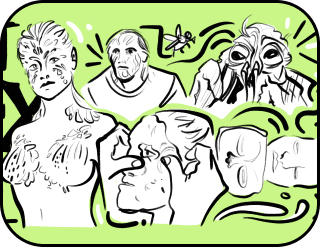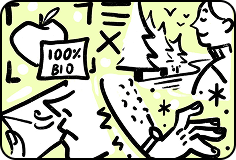Personal encryption: create your own digital signature
“What’s in a name?”
Alexander Pushkin
In the graduating class, seated at their desks, were Corinne, Olivia, Diane, and Eve. Yes, that’s right: the sum of the initial letters of the senior girls’ names forms the word “code.” An anagram. We couldn’t resist.
Let’s return to the classroom situation. When the teacher called out from the attendance list, “Diana, to the board!” three heads turned toward the window at once: one with a braid, another with a ponytail, and the third with impossibly curly hair. Nothing supernatural — each name was shared by more than one student.
To avoid offending anyone, the teacher listened to all three and gave them different grades, of course.
What is the question of this problem?
How to “encrypt” yourself so that the right key instantly unlocks the unique “I” with all its “tails”?
We’re already running to the board with two possible answers.
This world was invented long ago, not by us. Whoever seeks shall always find a medieval solution to a modern problem. And adapt it—if possible.
Shall we try?
Let’s start with the family coat of arms.
The “fashion” for this type of personal data encryption was introduced by medieval knights. A coat of arms helped distinguish tournament participants hidden behind the anonymity of their armor. For the uninitiated, this cryptogram of family history looks like a collage of animalistic illustrations from a children’s fairy tale book. The key to deciphering it lies in the field of heraldic knowledge.
Birds and animals in this system carried information about both the ancestors of the “encrypted” individual and the person themselves. On old Russian family crests, a double-headed eagle signified noble lineage; a white horse and a lion represented bravery and strength; a unicorn symbolized caution; swords, grenades, and cannons—expectedly—stood for military achievements of the family’s representatives. The family motto was placed on a ribbon encircling the coat of arms.
How freely could all the puzzle elements be interpreted?
The room for maneuver was limited by strict rules. In Russia, the first collection of heraldic symbol interpretations, Symbols and Emblemata, was published in the early 18th century. Around the same time, the position of herald master (a kind of cryptographer) was introduced. In reality, the key to deciphering a coat of arms was publicly available.
A family or personal secret could “hide” in the heraldic motto. The inscription, usually in the national language or Latin, referenced a significant event in the family’s history or reflected the owner’s life philosophy. For example, the “speaking” motto of the Demidov family, “By deeds, not words,” recorded their renowned business achievement—the establishment of an iron foundry near Tula. The motto on the Lermontov family crest, “Sors mea – Jesus” (“My fate is Jesus”), still intrigues those who cherish the memory of the poet who tragically left this world too soon. It is known that this timeless hero carried a handkerchief embroidered with the family motto.
Acquiring a coat of arms was a costly and labor-intensive endeavor. The encryption was meant for the privileged. Those who desired one had to prove their noble ancestry and demonstrate service to the nation. A properly composed identifying cipher for a family was officially approved.
A legally recognized coat of arms became a part of everyday life: it adorned noble estates, was used in correspondence, and decorated family dinnerware and tablecloths. It remained with its owner to the grave—literally: in noble cemeteries, this symbol replaced modern-day ritual photographs. The memory of noble lineage and the glorious deeds of its best representatives was securely immortalized. Modern heraldic experts can interpret the symbolism, and the mottos can be understood—at least in broad strokes.
However, identifying a specific individual often proves impossible. This encryption system did not withstand the test of time.
Even today, it is possible to create a personal family crest. The real question is how it will be used in the future. State-appointed herald masters have long been out of service. Even with a presented coat of arms, you won’t be able to book a dentist appointment, regardless of your noble lineage or your ancestors’ military achievements. Displaying a colorful illustration featuring a lion and a cannon does not provide the required speed and accuracy to identify the individual behind it. Instead, a family crest serves the honorary function of a heritage cipher.
Now, let’s move on to a more budget-friendly way of self-encryption—the monogram.
The task is to weave the initials of one’s name and surname into a single symbol (the Greek word monogram literally means “one letter”) or to place them side by side. The ancient Egyptians and Greeks still dispute authorship of this cryptographic idea in academic works. And for good reason! This know-how has stood the test of time and remains popular today.
One might mistakenly assume that intertwining initials is a simple task. Not quite. The cipher is not as straightforward as it seems. For example, Peter the Great’s monogram emerged from the fusion of twin Latin letters “P.” One interpretation is that it stands for Petrus Primus (Peter the First). Another version suggests that the ruler’s name is represented “in a square,” stylized in a mirror image following the baroque aesthetic.
A single “signature” letter not only indicated the owner’s name but also carried additional meanings: power, status, reputation, and fame. The monogram was imprinted on coins, works of art, and personal belongings. Today, this type of cipher is still at the peak of popularity. It has infiltrated the realm of premium branding. Iconic monogrammed logos—Gucci, Chanel, Louis Vuitton—have immortalized the names of their founders.
If a monogram doesn’t have room for all the details—curls, freckles, and everything else you’d like to share about yourself—why not tie it into a knot? In Polish, the word venzel literally means “knot.”
This cipher can be considered a spin-off of the family crest: heraldic symbols and decorative elements soften the monogram’s minimalism. The venzel was once regarded as such a secure form of personal encryption that in the Middle Ages, high-ranking officials used it as a signature on state documents. The elaborate symbol also marked the ownership of valuable items—jewelry, ex-libris bookplates, and even everyday personal objects, from towels to soup tureens.
So, are we encrypting by digitizing? Here, have some embroidered handkerchiefs with venzel initials. What’s that? You don’t use those? Your mom buys disposable ones? Just like Nikita, Ilyas, and Artem? Understood. Let’s keep the impossibly curly venzel designs to ourselves.
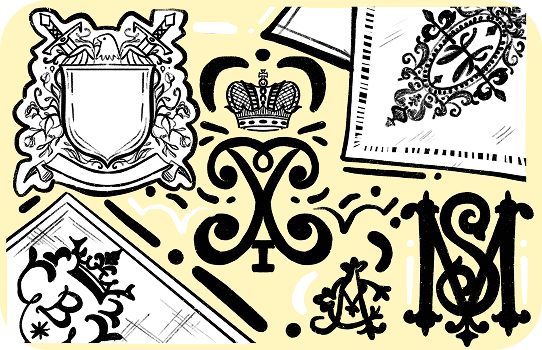
Is it time to place personal QR codes on school desks? After all, for a teacher’s scanning device, a student’s identity would be crystal clear—literally, with a key to their personal cipher hanging around their neck.
Scanning a QR code takes mere seconds (quick response means “fast reply” in English) and grants access to encrypted data. There’s no need to unravel the intricate knots of family history. The black-and-white pattern is both decorative (where have we seen a black square before?) and highly functional. You can encrypt text, images, and even sound. For our purposes, a digital report card for the class’s top student could be generated at home. The QR code, when scanned, would instantly display all the student’s details, show a photo, and even play a recording of their voice.
But what if a curious student decides to “enhance” the pixelated image with their own ink squares? No worries—QR code technology is designed to withstand damage. As long as 70% of the pattern remains intact, the scanner can still retrieve the information.
And yet, a classroom-wide QR code system is a modern yet risky technological solution. The reaction from some parents is predictable. Comparisons to supermarket product labeling are almost inevitable.
Plan “B”—Which Starts with “A”
Avatar. A profile picture on social media speaks volumes—far more than a name. The amount of encrypted information it holds is enough to plunge into subconscious depths that even the person behind the avatar hasn’t explored yet. This isn’t just speculation—it’s what psychologists suggest. The key to decoding avatar-based ciphers is found through intuition, and the interpretations are often presented as universal truths.
Someone replaces their own photo with a poster of a TV actor? Exposed: they struggle with self-acceptance. Changing the poster every five days? That’s not a good sign—it suggests dissatisfaction with life and a deep need for attention, at the very least.
It’s hard to believe it’s that simple, isn’t it? Maybe our top student with the ponytail just wanted to have some fun by presenting herself as a cartoon character from a small-town setting. If “a person’s soul is a mystery,” then their encrypted version is utter darkness. Our only hope lies in cipher-psychologists. But such specialists don’t exist. Not yet. We’ll wait for them to arrive so they can help us understand why a sweet, innocent child would encrypt themselves as a fierce, avatar-based lion.
Or, we can take an alternative approach: we can suggest that the class communicate in a shared cipher language—one that’s already popular. Emojis.
Nowadays, internet users encode proverbs, classic literary titles, and famous movies into these tiny digital symbols. This viral trend has taken over the online playing field. Let’s practice! Try translating these well-known truths from the language of pictures:
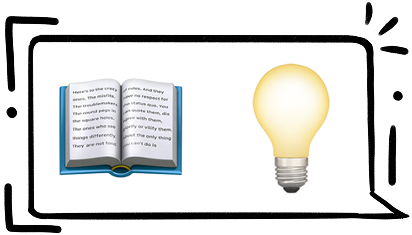
Learning is light? Reading is a source of inspiration?
Hard to say. We must have dropped the cipher key somewhere in the school hallway.
But emojis don’t always smile kindly. Their meanings are often ambiguous, and the true intent behind them sometimes hides beneath the surface, like the unseen part of a communication iceberg. Take the emoji of two hands pressed together. Many assume it represents a Christian prayer. In reality, it was originally a visual representation of a thank-you gesture commonly used in Japanese culture. So, the message should be interpreted as “thank you,” not the commonly mistaken “please.”
All we can do is wonder about the emotional state of someone who reads this symbol as “thanks in advance.”
We Could Try Generating Meme-Based Nicknames for Our Bored Students, Encrypted in a Similar Way:

“Seeker of Perfection”—Our Ciphered Version.
A next-generation monogram equivalent will definitely come in handy for quickly identifying identical winter jackets in the school locker room.
The boys and girls seem easy to figure out. But what about their parents? It’s not entirely clear who exactly signed up at the last parent-teacher meeting to personally handle the classroom renovations. The issue wouldn’t have arisen if the protocol hadn’t been handwritten on someone’s knee but instead created as a digital file on the teacher’s computer and signed by the parents using an electronic signature (ES).
Parents wouldn’t even need to bring a pen—just a physical device with an ES, like a token resembling a regular flash drive. Forgetful ones could use a cloud-based signature instead. This cipher holds data on who and when signed the document (though the why remains open to debate). The ES file always follows the signed document. A special service verifies the authenticity of the signature and the validity period of its certificate. Moreover, the key allows detection of any modifications to the original file. A digital version of a handwritten signature also keeps the document hidden from prying eyes—perhaps even from the school principal.
But will our technological solutions survive until the next graduation?
After all, it’s not just technology that fades away. We, too, are not eternal. When planning for the inevitable, how should we handle our personal ciphers, and where should we securely store the key for our heirs?
Our imagination is already conjuring up a tombstone with a QR code instead of a traditional portrait. Not long ago, a family crest would have been displayed in that sacred space. Sure, it’s a convenient and familiar format. But will scanners capable of decoding a digital business card still exist by the time Year X arrives? Technology ages. Some things become obsolete beyond repair—without the possibility of an upgrade.
A futuristic solution to this dilemma is proposed by our compatriot, Dmitry Itskov. This “modest producer of immortality” (as he calls himself) is developing technology to extract the “self” from its physical shell and upload it into the global network. Transferring consciousness from the brain to a timeless digital carrier would grant immortality. The owner of an encrypted consciousness could, using the right set of keys, access their digital self and continuously refine it into the “best version.”
All of this is not far off. The breakthrough is promised by 2045. If we live to see it, we’ll meet again—perhaps in a virtual bar of the next millennium, at an avatars’ graduation party.
For the “here and now,” we have an exclusive solution. Only for readers of our high-tech journal, we are offering a key. A key to the digital international art space—Global Wall. It will outlive all technology. It will preserve you at your best. Securely and creatively. Your unique digital footprint will remain here in any form of personal cipher you choose—from a monogram to an avatar.
“Spring,” O-90 smiled at me in pink, one of the students began reading an excerpt from Yevgeny Zamyatin’s We with great expression. The very passage where nameless characters, encrypted as “state numbers,” stroll along a springtime avenue.
The teacher glanced anxiously at three heads—one with braids, one with a ponytail, and one impossibly curly. A mysterious name or a recognizable cipher? Communication technology is a delicate thing. A bit of mystery wouldn’t hurt.
Perhaps.
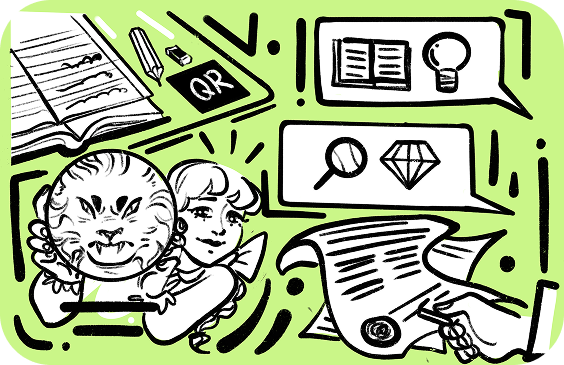
The cell divides into the nucleus and cytoplasm. Our journal divides into interesting facts and discoveries.
Thank you!


